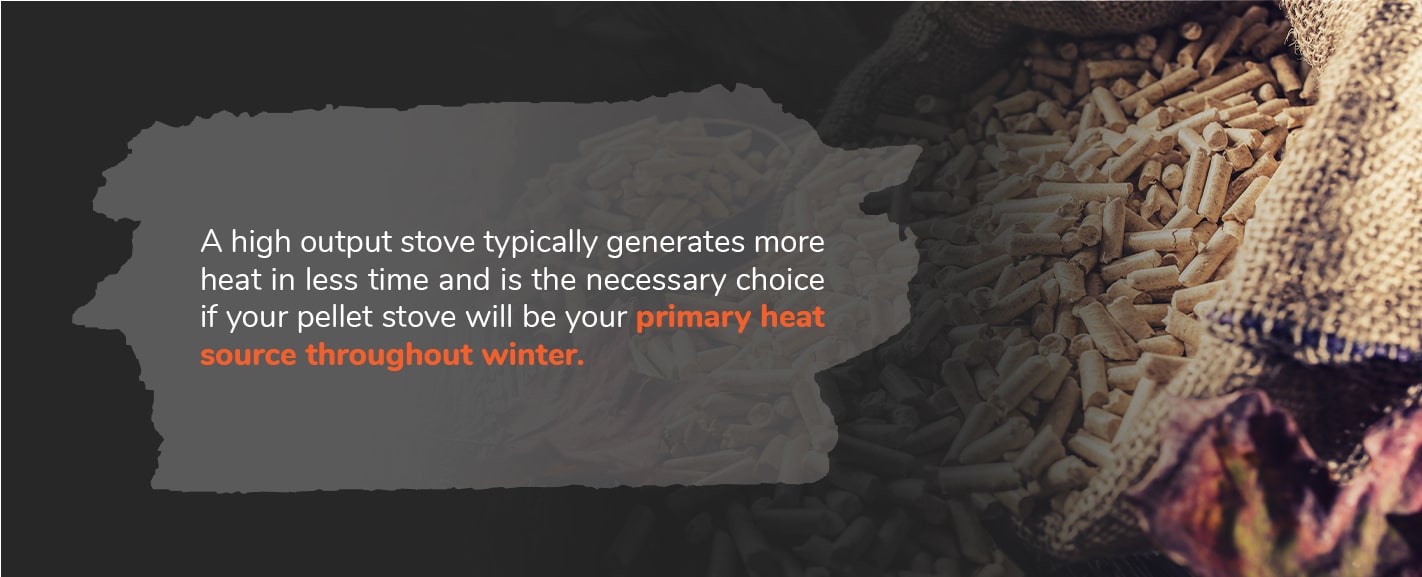How to Choose the Right Pellet Stove for Your Home

Pellet stoves offer a cleaner and simpler alternative for home heating at similar or lower costs than gas stove systems, but how do you know which one is best for your family? Homes come in all shapes and sizes. A single-level Craftsman house has different heating needs than a multi-level condominium. Heating your home effectively means choosing the right type and size pellet stove for your unique needs and maintaining it with high-quality heating pellets, regular inspections and thorough cleaning.
This article will help you learn more about choosing the right pellet stove for your home.
Types of Pellet Stoves
Pellet stoves vary depending on their design, power input and method of fuel consumption:
- Freestanding vs. inserts: Pellet stoves are available as either freestanding units or fireplace inserts. You can place a freestanding unit near an electrical outlet in any adequately ventilated room, which may require some minor construction in your walls or ceiling to add ventilation ducts. Fireplace inserts sit directly inside your existing masonry and are more efficient at home heating than traditional wood-burning fireplaces. Some inserts might require a chimney liner to accommodate ventilation and changing emissions.
- Bottom-fed vs. top-fed: “Feeding” refers to how a pellet stove distributes its wood pellets in relation to the auger, fire chamber and ash movement. Top-fed pellet stoves have an angled auger that drops pellets into the combustion chamber from the top or side of the stove, minimizing burnback but potentially creating more ash deposits that could inhibit airflow or flame strength in the process. Bottom-fed pellet stoves distribute the pellets horizontally into the chamber, clearing away any ash deposits or build-up and creating a steady flame. These units require a low-ash pellet to be successful.
- Electric vs. manual power: Some electric pellet stoves have a built-in backup battery, so you can keep warm if your electricity goes out without needing a large generator. While most pellet stoves operate via electricity, there are also some manual pellet stoves on the market for off-grid homes or outdoor applications.
Pellet stoves are also available in multiple styles and designs to suit different decorating tastes. Some have intricate wood or metal work, decorative fixtures or special finishes to fit different interiors, whether rustic, modern, farmhouse or vintage-inspired.

Choosing the Right Size Pellet Stove
Each pellet stove should have a listed energy output and British thermal unit (Btu) rating. A high output stove typically generates more heat in less time and is the necessary choice if your pellet stove will be your primary heat source throughout winter. Low output units are a good alternative for irregular use or a supplemental form of indoor climate control.
Using a pellet stove with the correct Btu rating is essential. A unit with a higher Btu than needed will generate too much heat for your home, creating an uncomfortable and potentially hazardous environment. Undersized units won’t generate enough heat to keep you, your family or your plumbing warm enough to act as a primary heat source. Most stoves at 60,000 Btu can adequately heat a 2,000-square-foot-home, while units rated at 42,000 Btu can handle about 1,300 square feet.
While a pellet stove’s Btu rating is a key component for home heating, it’s not the only one to consider. Multiple factors — some you can control and some beyond your scope — combine and work off one another, including:
- How well your home is insulated, including walls, flooring and around doors and windows.
- The number of windows in the same room as your pellet stove.
- The amount of space between the stove and ceiling.
- How well air circulates naturally through the room and whether a fan is needed to assist.
- The average climate and weather conditions in the winter, including ice accumulation on your home’s exterior.
- Whether the stove is a primary or supplemental heating source.
- How many rooms you’re trying to heat with a single stove.
- The size of the hopper on your pellet stove and how much volume it can hold in a day.
- Consistency with cleaning, managing and refilling the pellet hopper.
- How often you use the stove and the amount of time between uses.
- Whether or not the pellet stove is placed in an optimal part of the room.
- Pellet fuel availability, quality and consistency.
How Long Does an indoor Pellet Stove Last?
Pellet stove flames last as long as the wood pellets inside do, which depends on the size of the hopper and pellet fuel quality. An average bag of wood pellets is 40 pounds, which generates 24 hours of heat. Most homes require between 2 tons and 5 tons of pellets — about 100 to 250 full-size bags — to last all winter, though that amount may increase or decrease depending on how extreme your winters are, how long they last and whether you’re supplementing your indoor pellet stove with another form of indoor heat.
If you’ve invested in the right size stove, then the heat from a pellet stove ranges from lasting a few hours to all night long, depending on the pellet quality and your maintenance routine:
- Pellet quality: The best wood pellets are those that don’t produce excessive amounts of ash, have a low moisture content and are sourced from clean, virgin wood fibers. One way to ensure you’re using top-quality pellets is to look for a label marking it certified by the Pellet Fuels Institute (PFI). A PFI-certified pellet means the manufacturer has met and maintained strict quality standards. Preserve pellet quality by storing them in an airtight container, off the ground, safe from humidity and moisture.
- Maintenance routine: As ash and other residue build up inside your stove, it can create “clinkers,” or deposits, that limit airflow and suffocate the flame. This makes your stove less effective and wears down its components if left unchecked. Proper pellet stove maintenance includes cleaning it regularly. Scrape the burn pot at least once per day and inspect vent pipes to clear them as needed. Dump the ash pan at least once a month or weekly, depending on size and frequency of use. Deep clean each component once a week for optimal performance.
Pairing Your indoor Pellet Stove With Accessories
In addition to using low-ash, low-moisture pellets, pair your stove with optional accessories to get more out of your investment, including:
- Decorative faux “firewood” for insert units.
- Cast iron steamer pots to act as a natural home humidifier.
- Remote controls for temperature adjustments.
- Stove-top scent warmers.
- Comprehensive cleaning kits, including ash buckets and scraping tools.
- Hopper extenders to get more life out of your pellet load.
- Scuttles to store smaller pellet portions for easy access overnight.
Get Premium Wood Pellets From Energex
While choosing the correct unit type, size and style are critical, your pellet stove’s flame quality and longevity depend on the fuel you choose. Energex has more than 25 years of experience sourcing and producing premium PFI-certified softwood and hardwood heating pellets for homes and businesses along the East Coast. Protect your investment and create a cleaner burn that will keep your family warm all winter long.
Learn more about our heating wood pellets, or find an Energex dealer near you today!


